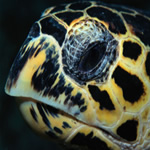




Hawksbill Turtle ConservationScientific name: Eretmochelys imbricata IUCN Status: Critically Endangered (at extremely high risk of extinction in the wild) CITES: Appendix I (international commercial trade banned) Habitat: Warm waters of the Pacific, Atlantic and Indian Oceans. Usually found in shallow waters where they forage in coastal areas, bays, mangrove areas and estuaries. Particularly fond of rocky areas with corals and coral reefs. conservation efforts: A number of organisations around the world are working to help these and other endangered marine turtles. One of the biggest challenges, and arguably the most important, is education. This includes education of visitors when purchasing goods, and of future generations in areas where these turtles occur. If locals are able to see an intrinsic value in the turtles, as well as the eco-tourism potential, they are more likely to work to save them. Other measures introduced to curb population declines in some areas include “Turtle Exclusion Devices” which reduce incidental by-catch in prawn trawling nets, tougher laws (although these are often not enforced) and re-release programs when turtles are captured in other types of fishing nets. About: Hawksbill turtles grow up to 90 cm long as adults - they are relatively small compared to other marine turtles. Adults have beautifully marked shells, with amber centred scales and radiating red, yellow, honey and black streaks. Hawksbills begin breeding at about 8-10 years of age, with mating taking place in shallow water off nesting beaches (males do not return to land). The females lay between 50 and 200 eggs from December to February. Hatchlings emerge about two months after eggs are laid, and are about 4 -5 cm in length. Juveniles tend to be herbivorous, feeding mostly on floating vegetation, whilst adults are carnivorous, feeding on sponges, coral and jellyfish amongst other things. The turtles tend to be nervous around humans, although in protected areas they can become tolerant of humans and are undisturbed by divers and snorkellers. Threats: This attractive turtle is under serious threat of extinction. The single greatest cause of its decline is its heavy persecution for its beautifully marked shell. The shell is the sole source of commercial “tortoiseshell”. Despite CITES (Convention for International Trade in Endangered Species) restrictions, the "tortoiseshell" is used to make combs and other curios for tourists. Tourists often buy these curios unknowingly – so please be aware when you are shopping and remember not to purchase anything that is made from threatened or endangered species. Further threats include incidental capture in fishing nets where the turtles are simply discarded, poaching of adults and eggs for human consumption, and loss of nesting beaches to development. Another serious threat for these gentle creatures is that they often mistake plastic bags for jellyfish and eat them. The plastic bags become lodged in their gut, eventually killing them. |
Marine Turtle ConservationMonitor nesting turtles Turtle hatchling count
"The volume of trade in Hawksbill shells is horrifying; in one year Indonesia and Japan imported 260 000 kg of raw shell; the adults are sometimes de-shelled alive and there is also an unpleasant trade in stuffed juveniles."
Learn more about Hawksbill Turtles |
|
|
||
All Rights Reserved
East
Africa Diving | Zanzibar | Mafia | Pemba | Africa Diving | Whale
Sharks | Mnemba Atoll | Indian Ocean Diving info@EastAfricaDiving.com Terms of Use. Privacy Policy. Brought to you by ConservationSafaris.com |
